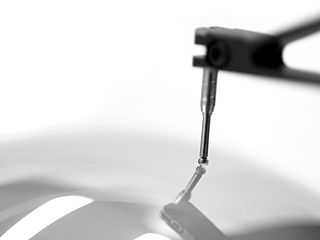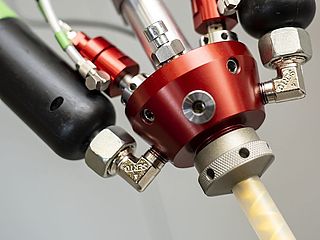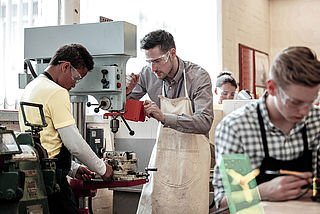Mahr
|
Gaging Tips
Data Collection Goes Integrated Wireless
|
Marketing Team
| About 30 years ago, the concept of data collection for process control took a major leap forward. This was about the time that a combination of electronic technology and economics allowed gaging to become digital. With a digital signal available, it became possible to transfer information via cable directly from a gage or digital indicator to the data collector. This made it much more practical to make process control decisions based on statistical analysis. Electronic data collection also occasioned a major improvement in data quality. Prior to this leap, data was either handwritten onto a sheet of paper and then logged into a computer, or it was logged into the computer directly at the point of gaging. You can easily understand how an operator, sitting at a bench measuring hundreds of parts, could transpose numbers, skip digits, or just enter wrong numbers. These problems were virtually eliminated by having data go directly to the data analysis software. When electronic data collection strategies were first implemented, it was not unusual to see collection efficiencies and error reduction increase 10-fold over manual collection methods. These days, checking parts at a gaging station with a hand tool or a dedicated fixture gage connected to a computer via a cable for data collection is the norm. Today's hand tools and digital indicators have data output built in, and collecting data is easy and very cost effective. It is also inexpensive, fast and reliable, and provides a great solution for many process or quality control applications. But what happens when the part can't be brought to the bench? Maybe it's still in the machine or it is simply just too large to bring to the gaging station. Running a long cable from the gage to the computer can be a hazard, and if multiple dimensions need to be checked with different gaging, a collection of long cables can quickly become a snarled mess. Technology is ready to take another leap. Just as cell phones and wireless computer peripherals have become common, wireless technology is moving out onto the shop floor. Small transmitters are now being built into digital indicators that allow them to transmit data to the gaging computer. Each integrated transmitter in the digital indicator uses slightly different signal coding that allows many gaging stations to communicate to a single computer simultaneously. Today these transmitters are not that much more expensive than data cable, making the cost more than justifiable when cabling alone won't get the job done. So now, with these transmitters, very large parts can be measured where they sit, or parts can be measured in the machine tool without having cables get caught in the tooling. Plus, many digital indicators provide feedback by generating a signal to the operator that the transmission was received and acknowledged by the computer. This is virtually instantaneous so as not to slow the operator down, and most transmitters can be configured to provide a go or no-go signal to the user depending on whether the part is within tolerance. Another application might be for multiple digital indicators being used on one gaging fixture. Usually each digital indicator would have its own cable, and since there are so many, some type of interface box would be required to handle multiplexing the signals to the computer. With the integration of the transmitter, both the cabling and the multiplexers are eliminated. Not to mention a cleaner looking gaging station. In addition, the PC running the data collection software can be triggered by the operator to gather the data from the multiple digital indicators. Eliminating cables is great, but probably the best application for this technology is right at the machine tool. Transmitted wirelessly into the machine tool's controller, the data can be put to use as part of the calculation for offsetting. Thus, as the operator measures the parts, the data is used to assign the proper offsets, greatly improving the quality and throughput of the machine tool. Out-of-spec parts are virtually eliminated, and the ability of the machine to make parts to the desired dimensions is greatly improved. At the same time, the data can be stored for long-term archiving, recording when the part was measured and by whom. It can also be used for tracking and improving operator throughput. Today the triangle is becoming complete, with a combination of digital gaging for accurate shop floor measurement, unrestricted wireless transmission of reliable data, and statistics for process control. These three tools allow for truly effective use of measurement data. Transmitted wirelessly into the machine tool's controller, the data can be put to use as part of the calculation for offsetting. Thus, as the operator measures a part, the data is used to assign the proper offsets, greatly improving the quality and throughput of the machine tool. |


















